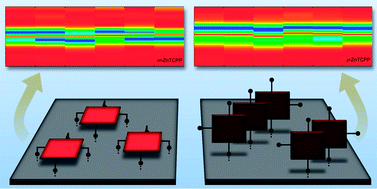J. Roales, J.M. Pedrosa, M. Cano, M.G. Guillén, T. Lopes-Costa, P. Castillero, A. Barranco, A.R. González-Elipe
RSC Advances, 4 (2014) 1974-1981
doi: 10.1039/C3RA42443J

The optical gas sensing properties of Zn-(II)-5,10,15,20-tetra(3-carboxyphenyl)porphyrin (m-ZnTCPP) and Zn-(II)-5,10,15,20-tetra(4-carboxyphenyl)porphyrin (p-ZnTCPP) bound to microcolumnar TiO2 thin films have been compared and explained in terms of their different molecular structure and anchoring to the titania surface. This different binding has been confirmed by specular reflectance FTIR revealing that m-ZnTCPP is bound by its four carboxylic groups in contrast to p-ZnTCPP where two or three of these groups remain unanchored. As a consequence, the Soret band of the para derivative is blue shifted with respect to the solution, indicating H aggregation, while m-ZnTCPP remained in its monomeric form due to the planar anchoring by the four COOH groups to the titania matrix that would avoid porphyrin aggregation. The sensing performance of the two systems has been assessed by analyzing the spectral changes in their UV-visible spectra under exposure to six volatile organic compounds. Although the highly porous and non-dispersive TiO2 matrix allow good sensing ability in both cases, the response of the m-ZnTCPP/TiO2 composite has been found to be more intense and faster than that of p-ZnTCPP. Moreover, the use of identification patterns also indicates that the meta derivative achieves a more selective recognition of the selected analytes. This improvement in the sensing capabilities of m-ZnTCPP has been attributed to the absence of aggregation between adjacent macrocycles.

